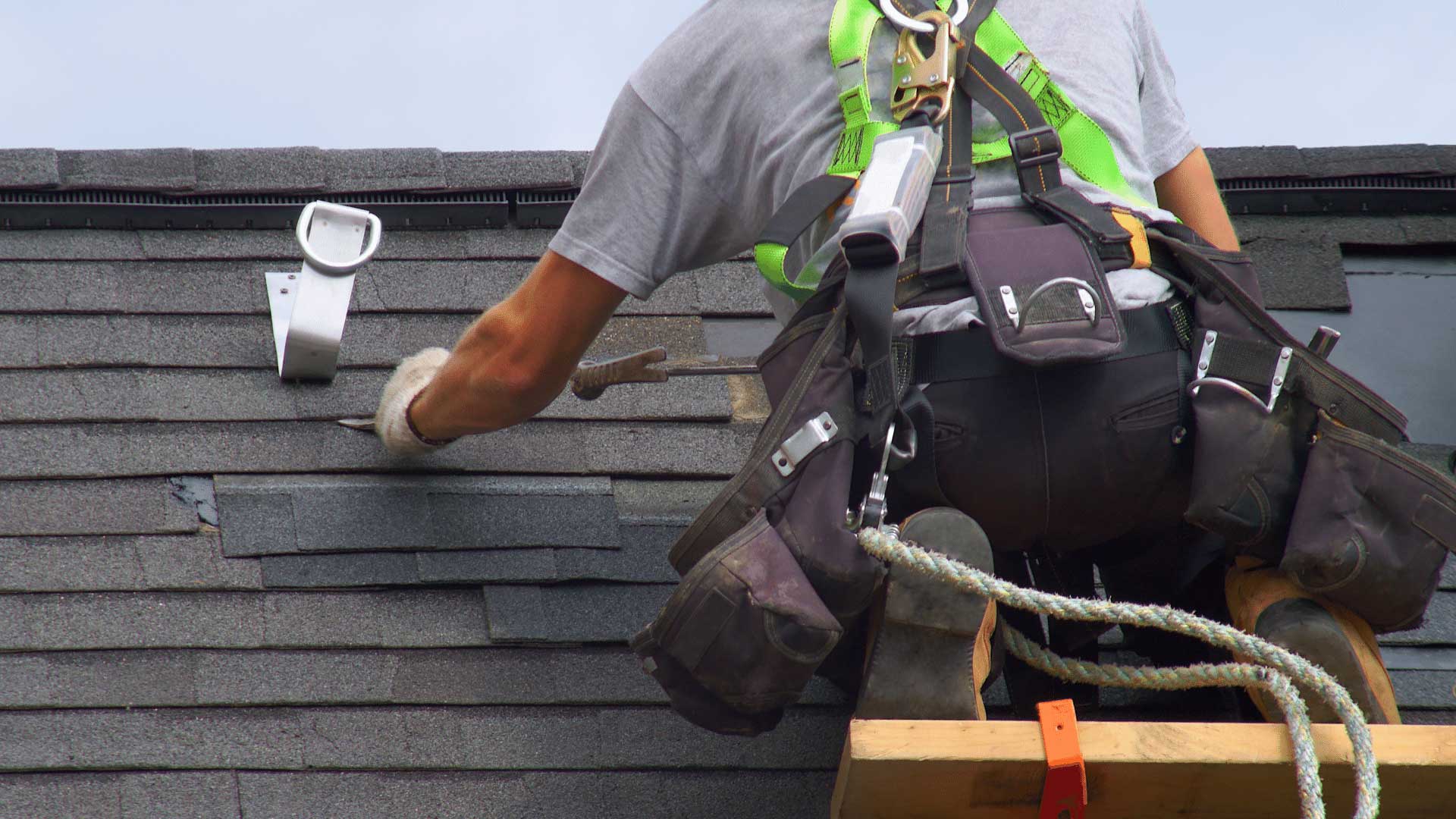Preparing a roof for harsh weather is an important task that requires adequate knowledge and skill. With the right preparation, homeowners can ensure their roofs are adequately protected from extreme weather conditions.
This article provides detailed guidance on how to best prepare a roof in order to protect it from damage caused by severe weather. It explains the necessary steps required to secure a roof against rain, wind and snow, as well as other potential sources of harm.
Additionally, it offers tips on how to identify warning signs that could indicate more serious structural issues with one’s roof. By following these instructions and keeping an eye out for any potential problems, homeowners will be able to guarantee their roofs remain sturdy during periods of bad weather.
Inspecting The Roof
Preparing a roof for harsh weather requires careful inspection of the entire structure. This includes checking ventilation, inspecting shingles and identifying signs of damage or wear.
Ventilation should be checked to ensure air is flowing freely from soffits around the eaves up through attic vents at the peak of the roof. If ventilation is blocked, it can cause condensation build-up which can lead to mold growth or interior water damage.
Additionally, damaged or curled shingles need to be replaced immediately as they will not properly protect against wind and rain. Any loose nails also need to be tightened or replaced in order for them to hold secure during high winds or storms.
Inspecting flashing on chimneys, skylights and other protrusions is also important when preparing a roof for harsh weather conditions. Flashing helps keep water out by creating an additional barrier between two different surfaces such as brick and wood. Cracked caulking needs to be removed and replaced with appropriate materials that are designed specifically for outdoor use in order to create a waterproof seal.
Lastly, cleaning gutters and downspouts regularly throughout the year prevents clogging that could potentially result in leaks inside buildings due to water accumulation. Taking these preventive measures along with regular inspections will help maintain a strong and durable roof ready for any type of weather condition it may face.
Cleaning The Gutters

The gutters of a roof play an important role in providing protection from harsh weather, and require regular maintenance to ensure they remain clean.
Power washing is the most effective way to remove buildup along the edges of the roof and within the gutter system itself. It can also be used to clear away debris that has accumulated on other parts of the roof surface. Additionally, seal coating should be applied prior to any power washing process as it will help protect against future damage caused by rain or snow. The combination of these two cleaning techniques helps ensure that your roof remains protected during inclement weather conditions, ensuring its longevity for years to come.
Once the initial cleaning process is complete, it’s essential to inspect all components of your gutter system for any signs of damage or wear-and-tear. If you find anything broken, cracked, or otherwise compromised, it must be replaced immediately so as not to allow further deterioration due to harsh weather elements such as ice and wind.
Regular inspection should become part of your routine when preparing your rooftop for any season and climate condition; this small effort can go a long way towards maintaining a safe level of protection throughout even the harshest storms ahead.
Re-Caulking Cracks And Seams
Gutters are an important part of the roofing system, but they need to be accompanied by other measures in order to protect a home from harsh weather.
The next step is checking seals and applying sealant around cracks and seams on the roof.
Before beginning any repair or maintenance work on the roof, it’s important to make sure that all safety precautions have been taken into consideration.
It’s also vital to inspect both sides of each shingle for any signs of damage such as missing granules, cracking, curling, or blistering.
If any of these issues are present, then repairs should be made before re-caulking begins.
Once this has been done, use a caulking gun filled with sealant appropriate for roof repairs to fill in any gaps between adjoining materials such as metal flashing and vent pipes.
Ensure that excess sealant is removed after application so it does not leak onto other areas of the roof when rain falls.
With proper preparation and maintenance your roof can stand up against even the most severe weather conditions!
Trimming Overhanging Trees
In order to effectively prepare your roof for harsh weather, it is important to trim any overhanging trees. Pruning branches and securing limbs can help keep the tree from damaging the roof when winds pick up or snow accumulates on its branches. By taking this precautionary measure ahead of time, you are better prepared for a season of strong storms and high winds.
When pruning branches, start by cutting off dead or diseased ones first as these will be weak and more likely to break during inclement weather conditions. Then remove any low-lying branches that could potentially hit the roof when they sway in heavy gusts of wind.
Be sure to also cut back branches that hang close to power lines – both for safety reasons and so they don’t interfere with electricity flow during bad weather.
Lastly, check nearby trees regularly throughout the year to make sure their limbs remain secure and away from your home’s rooftop. Taking preventive action before winter arrives can save you costly repairs down the road.
Securely Attaching Loose Shingles
After trimming any overhanging trees, the next step in preparing a roof for harsh weather is to securely attach loose shingles. This can be done by installing nails into each side of the affected shingle and then covering them with caulk or roof cement. If there are large gaps between shingles due to broken tabs, they should also be fixed using this method.
In addition, flashing around skylights or chimneys should be inspected and replaced if needed. Flashing helps keep moisture from entering your home through these areas and prevents damage caused by water accumulation. Installing new flashings requires extra care as it must fit properly against the surface to prevent leaks.
Caulking along seams will help provide an additional layer of protection against water infiltration. By following these steps, homeowners can ensure their roofs are better prepared to withstand extreme weather conditions like heavy rainstorms, hail storms, snowfall, high winds and more.
Taking time to inspect and repair roofs prior to tumultuous weather can help protect homes from costly repairs in the future.
Adding Insulation
Adding insulation to a roof is an important step for preparing for harsh weather. Insulation helps reduce the amount of energy used in heating and cooling, as well as preventing moisture from seeping into a home’s interior walls.
Many types of insulation are available, including spray foam, rigid board insulation, fiberglass batts, or cellulose loose-fill. It is also beneficial to add ventilation by installing soffits and ridge vents in order to create air circulation throughout the attic space.
In addition to adding insulation and ventilation, it is essential to use waterproof materials when covering a roof such as asphalt shingles or metal panels. Asphalt shingles come in various shapes and designs while metal roofs last longer but can be more expensive initially depending on the type chosen.
Proper installation techniques should always be followed when putting up any kind of material on a roof to ensure maximum protection from bad weather conditions. Regular maintenance should also be done which includes checking for signs of wear and tear every few months. Doing this ensures that your roof will remain sound even during extreme temperature fluctuations and severe rainstorms.
Monitoring For Warning Signs
It is essential to be proactive when it comes to preparing your roof for harsh weather conditions. Preventive maintenance can help identify potential issues before they become bigger problems, allowing you the time and opportunity to repair or replace any damaged components of your roof.
Monitoring for warning signs such as cracking shingles, peeling paint, broken gutters, and leaking roofs are all part of a regular preventative maintenance program that should be done in order to protect against possible damage caused by severe weather.
Weatherproofing techniques like installing skylight protection covers and applying sealant around chimneys also serve as an important preventive measure. Additionally, checking the flashing on the roof not only helps keep water out but also prevents moisture from entering through cracks or seams which could lead to mold growth or other structural damage over time.
Taking these steps will allow homeowners peace-of-mind knowing their roof is prepared for whatever Mother Nature sends its way.
Conclusion
It is important to ensure that a roof is prepared for harsh weather.
By performing regular inspections, cleaning the gutters, re-caulking cracks and seams, trimming overhanging trees, securely attaching loose shingles, adding insulation and monitoring for warning signs, one can take steps in order to protect their home from damage due to inclement conditions.
Taking these preventative actions will help extend the life of a roof and minimize costly repairs or replacements down the road.

